Angelika Romanou
CAVE: Detecting and Explaining Commonsense Anomalies in Visual Environments
Oct 29, 2025Abstract:Humans can naturally identify, reason about, and explain anomalies in their environment. In computer vision, this long-standing challenge remains limited to industrial defects or unrealistic, synthetically generated anomalies, failing to capture the richness and unpredictability of real-world anomalies. In this work, we introduce CAVE, the first benchmark of real-world visual anomalies. CAVE supports three open-ended tasks: anomaly description, explanation, and justification; with fine-grained annotations for visual grounding and categorizing anomalies based on their visual manifestations, their complexity, severity, and commonness. These annotations draw inspiration from cognitive science research on how humans identify and resolve anomalies, providing a comprehensive framework for evaluating Vision-Language Models (VLMs) in detecting and understanding anomalies. We show that state-of-the-art VLMs struggle with visual anomaly perception and commonsense reasoning, even with advanced prompting strategies. By offering a realistic and cognitively grounded benchmark, CAVE serves as a valuable resource for advancing research in anomaly detection and commonsense reasoning in VLMs.
Apertus: Democratizing Open and Compliant LLMs for Global Language Environments
Sep 17, 2025



Abstract:We present Apertus, a fully open suite of large language models (LLMs) designed to address two systemic shortcomings in today's open model ecosystem: data compliance and multilingual representation. Unlike many prior models that release weights without reproducible data pipelines or regard for content-owner rights, Apertus models are pretrained exclusively on openly available data, retroactively respecting robots.txt exclusions and filtering for non-permissive, toxic, and personally identifiable content. To mitigate risks of memorization, we adopt the Goldfish objective during pretraining, strongly suppressing verbatim recall of data while retaining downstream task performance. The Apertus models also expand multilingual coverage, training on 15T tokens from over 1800 languages, with ~40% of pretraining data allocated to non-English content. Released at 8B and 70B scales, Apertus approaches state-of-the-art results among fully open models on multilingual benchmarks, rivalling or surpassing open-weight counterparts. Beyond model weights, we release all scientific artifacts from our development cycle with a permissive license, including data preparation scripts, checkpoints, evaluation suites, and training code, enabling transparent audit and extension.
PERK: Long-Context Reasoning as Parameter-Efficient Test-Time Learning
Jul 08, 2025Abstract:Long-context reasoning requires accurately identifying relevant information in extensive, noisy input contexts. Previous research shows that using test-time learning to encode context directly into model parameters can effectively enable reasoning over noisy information. However, meta-learning methods for enabling test-time learning are prohibitively memory-intensive, preventing their application to long context settings. In this work, we propose PERK (Parameter Efficient Reasoning over Knowledge), a scalable approach for learning to encode long input contexts using gradient updates to a lightweight model adapter at test time. Specifically, PERK employs two nested optimization loops in a meta-training phase. The inner loop rapidly encodes contexts into a low-rank adapter (LoRA) that serves as a parameter-efficient memory module for the base model. Concurrently, the outer loop learns to use the updated adapter to accurately recall and reason over relevant information from the encoded long context. Our evaluations on several long-context reasoning tasks show that PERK significantly outperforms the standard prompt-based long-context baseline, achieving average absolute performance gains of up to 90% for smaller models (GPT-2) and up to 27% for our largest evaluated model, Qwen-2.5-0.5B. In general, PERK is more robust to reasoning complexity, length extrapolation, and the locations of relevant information in contexts. Finally, we show that while PERK is memory-intensive during training, it scales more efficiently at inference time than prompt-based long-context inference.
WikiMixQA: A Multimodal Benchmark for Question Answering over Tables and Charts
Jun 18, 2025Abstract:Documents are fundamental to preserving and disseminating information, often incorporating complex layouts, tables, and charts that pose significant challenges for automatic document understanding (DU). While vision-language large models (VLLMs) have demonstrated improvements across various tasks, their effectiveness in processing long-context vision inputs remains unclear. This paper introduces WikiMixQA, a benchmark comprising 1,000 multiple-choice questions (MCQs) designed to evaluate cross-modal reasoning over tables and charts extracted from 4,000 Wikipedia pages spanning seven distinct topics. Unlike existing benchmarks, WikiMixQA emphasizes complex reasoning by requiring models to synthesize information from multiple modalities. We evaluate 12 state-of-the-art vision-language models, revealing that while proprietary models achieve ~70% accuracy when provided with direct context, their performance deteriorates significantly when retrieval from long documents is required. Among these, GPT-4-o is the only model exceeding 50% accuracy in this setting, whereas open-source models perform considerably worse, with a maximum accuracy of 27%. These findings underscore the challenges of long-context, multi-modal reasoning and establish WikiMixQA as a crucial benchmark for advancing document understanding research.
Kaleidoscope: In-language Exams for Massively Multilingual Vision Evaluation
Apr 09, 2025Abstract:The evaluation of vision-language models (VLMs) has mainly relied on English-language benchmarks, leaving significant gaps in both multilingual and multicultural coverage. While multilingual benchmarks have expanded, both in size and languages, many rely on translations of English datasets, failing to capture cultural nuances. In this work, we propose Kaleidoscope, as the most comprehensive exam benchmark to date for the multilingual evaluation of vision-language models. Kaleidoscope is a large-scale, in-language multimodal benchmark designed to evaluate VLMs across diverse languages and visual inputs. Kaleidoscope covers 18 languages and 14 different subjects, amounting to a total of 20,911 multiple-choice questions. Built through an open science collaboration with a diverse group of researchers worldwide, Kaleidoscope ensures linguistic and cultural authenticity. We evaluate top-performing multilingual vision-language models and find that they perform poorly on low-resource languages and in complex multimodal scenarios. Our results highlight the need for progress on culturally inclusive multimodal evaluation frameworks.
Global MMLU: Understanding and Addressing Cultural and Linguistic Biases in Multilingual Evaluation
Dec 04, 2024



Abstract:Cultural biases in multilingual datasets pose significant challenges for their effectiveness as global benchmarks. These biases stem not only from language but also from the cultural knowledge required to interpret questions, reducing the practical utility of translated datasets like MMLU. Furthermore, translation often introduces artifacts that can distort the meaning or clarity of questions in the target language. A common practice in multilingual evaluation is to rely on machine-translated evaluation sets, but simply translating a dataset is insufficient to address these challenges. In this work, we trace the impact of both of these issues on multilingual evaluations and ensuing model performances. Our large-scale evaluation of state-of-the-art open and proprietary models illustrates that progress on MMLU depends heavily on learning Western-centric concepts, with 28% of all questions requiring culturally sensitive knowledge. Moreover, for questions requiring geographic knowledge, an astounding 84.9% focus on either North American or European regions. Rankings of model evaluations change depending on whether they are evaluated on the full portion or the subset of questions annotated as culturally sensitive, showing the distortion to model rankings when blindly relying on translated MMLU. We release Global-MMLU, an improved MMLU with evaluation coverage across 42 languages -- with improved overall quality by engaging with compensated professional and community annotators to verify translation quality while also rigorously evaluating cultural biases present in the original dataset. This comprehensive Global-MMLU set also includes designated subsets labeled as culturally sensitive and culturally agnostic to allow for more holistic, complete evaluation.
INCLUDE: Evaluating Multilingual Language Understanding with Regional Knowledge
Nov 29, 2024



Abstract:The performance differential of large language models (LLM) between languages hinders their effective deployment in many regions, inhibiting the potential economic and societal value of generative AI tools in many communities. However, the development of functional LLMs in many languages (\ie, multilingual LLMs) is bottlenecked by the lack of high-quality evaluation resources in languages other than English. Moreover, current practices in multilingual benchmark construction often translate English resources, ignoring the regional and cultural knowledge of the environments in which multilingual systems would be used. In this work, we construct an evaluation suite of 197,243 QA pairs from local exam sources to measure the capabilities of multilingual LLMs in a variety of regional contexts. Our novel resource, INCLUDE, is a comprehensive knowledge- and reasoning-centric benchmark across 44 written languages that evaluates multilingual LLMs for performance in the actual language environments where they would be deployed.
Could ChatGPT get an Engineering Degree? Evaluating Higher Education Vulnerability to AI Assistants
Aug 07, 2024
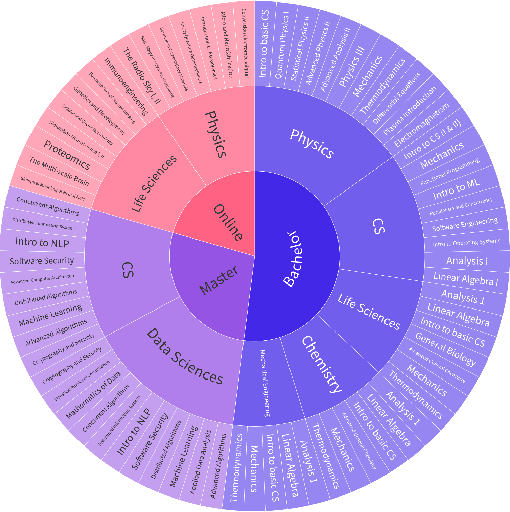
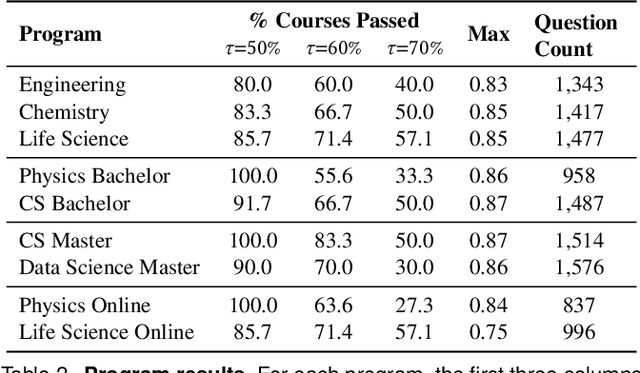

Abstract:AI assistants are being increasingly used by students enrolled in higher education institutions. While these tools provide opportunities for improved teaching and education, they also pose significant challenges for assessment and learning outcomes. We conceptualize these challenges through the lens of vulnerability, the potential for university assessments and learning outcomes to be impacted by student use of generative AI. We investigate the potential scale of this vulnerability by measuring the degree to which AI assistants can complete assessment questions in standard university-level STEM courses. Specifically, we compile a novel dataset of textual assessment questions from 50 courses at EPFL and evaluate whether two AI assistants, GPT-3.5 and GPT-4 can adequately answer these questions. We use eight prompting strategies to produce responses and find that GPT-4 answers an average of 65.8% of questions correctly, and can even produce the correct answer across at least one prompting strategy for 85.1% of questions. When grouping courses in our dataset by degree program, these systems already pass non-project assessments of large numbers of core courses in various degree programs, posing risks to higher education accreditation that will be amplified as these models improve. Our results call for revising program-level assessment design in higher education in light of advances in generative AI.
MEDITRON-70B: Scaling Medical Pretraining for Large Language Models
Nov 27, 2023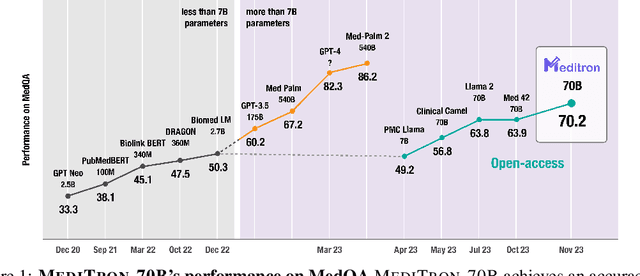
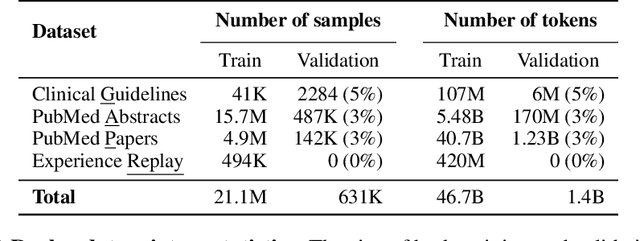
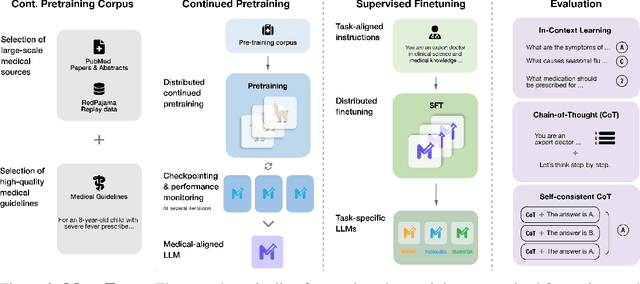
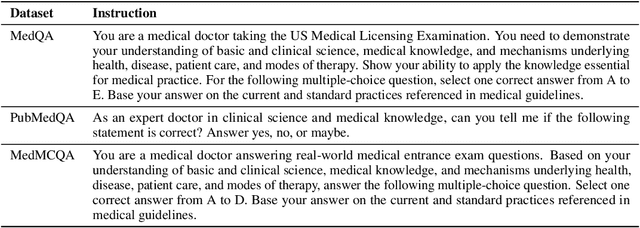
Abstract:Large language models (LLMs) can potentially democratize access to medical knowledge. While many efforts have been made to harness and improve LLMs' medical knowledge and reasoning capacities, the resulting models are either closed-source (e.g., PaLM, GPT-4) or limited in scale (<= 13B parameters), which restricts their abilities. In this work, we improve access to large-scale medical LLMs by releasing MEDITRON: a suite of open-source LLMs with 7B and 70B parameters adapted to the medical domain. MEDITRON builds on Llama-2 (through our adaptation of Nvidia's Megatron-LM distributed trainer), and extends pretraining on a comprehensively curated medical corpus, including selected PubMed articles, abstracts, and internationally-recognized medical guidelines. Evaluations using four major medical benchmarks show significant performance gains over several state-of-the-art baselines before and after task-specific finetuning. Overall, MEDITRON achieves a 6% absolute performance gain over the best public baseline in its parameter class and 3% over the strongest baseline we finetuned from Llama-2. Compared to closed-source LLMs, MEDITRON-70B outperforms GPT-3.5 and Med-PaLM and is within 5% of GPT-4 and 10% of Med-PaLM-2. We release our code for curating the medical pretraining corpus and the MEDITRON model weights to drive open-source development of more capable medical LLMs.
CRAB: Assessing the Strength of Causal Relationships Between Real-world Events
Nov 07, 2023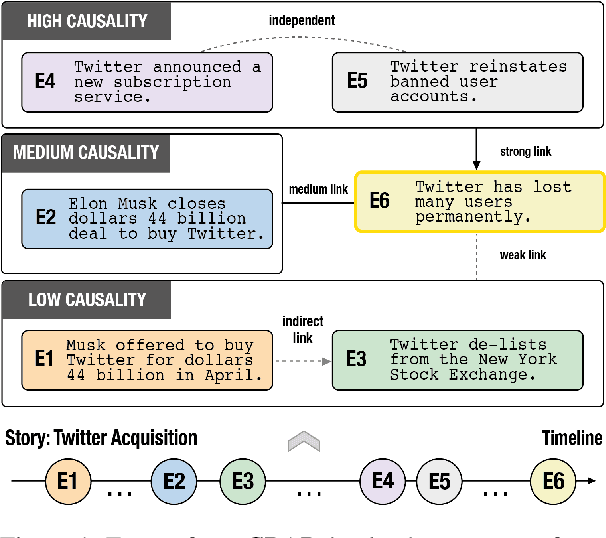

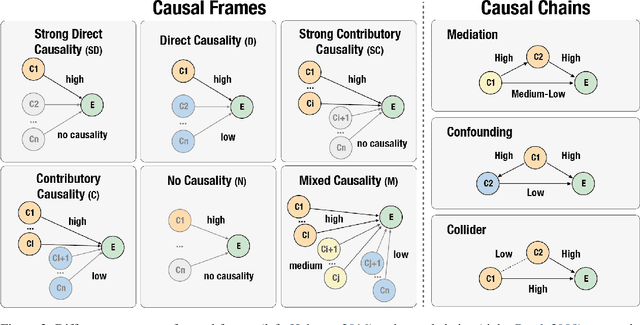
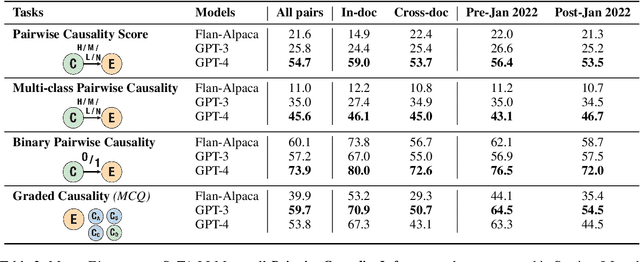
Abstract:Understanding narratives requires reasoning about the cause-and-effect relationships between events mentioned in the text. While existing foundation models yield impressive results in many NLP tasks requiring reasoning, it is unclear whether they understand the complexity of the underlying network of causal relationships of events in narratives. In this work, we present CRAB, a new Causal Reasoning Assessment Benchmark designed to evaluate causal understanding of events in real-world narratives. CRAB contains fine-grained, contextual causality annotations for ~2.7K pairs of real-world events that describe various newsworthy event timelines (e.g., the acquisition of Twitter by Elon Musk). Using CRAB, we measure the performance of several large language models, demonstrating that most systems achieve poor performance on the task. Motivated by classical causal principles, we also analyze the causal structures of groups of events in CRAB, and find that models perform worse on causal reasoning when events are derived from complex causal structures compared to simple linear causal chains. We make our dataset and code available to the research community.
 Add to Chrome
Add to Chrome Add to Firefox
Add to Firefox Add to Edge
Add to Edge